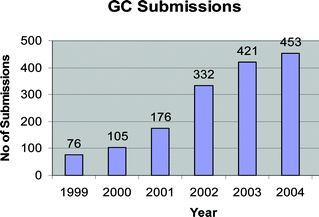Green Chemistry 2005: new look, new people, new chances
With the publication of this first issue of Green Chemistry in 2005, we would like to give you a brief update on the development of the journal in the past year and on some important changes that have been introduced with the beginning of this year.Journal changes
Readers will have noticed that the journal has a striking new look for 2005. The new modern cover design and size makes Green Chemistry immediately recognizable as part of the successful RSC journal family. Individual issues will now feature artwork from the most significant paper/review within the issue at the invitation of the Editor thus enhancing the impact of the journal.A news publication Chemical Technology forms part of the introductory pages of Green Chemistry. This publication draws together news and research highlights from a variety of RSC publications and provides a snapshot of developments across the chemical technology sector. The introduction of Chemical Technology also allows the inclusion of full colour contents lists with graphical abstracts making it easier for you to browse for your favourite article when Green Chemistry arrives on your desk. To enhance readability and impact further the font size in the journal has also been increased.
Furthermore, you will notice that “G” pages have disappeared from the journal in order to achieve greater consistency with other RSC journals. The news material will, however, remain an important part of the journal and we encourage the submission of essays, conference reports and other relevant information to the News Editor.
Editorial Board changes
With the turn of the year, the Editorial Board has also seen considerable changes owing to the fact that a number of members have completed their term at the end of 2004. Throughout the year, there are still other changes in the pipeline as current members complete their three year terms and we will announce these at the appropriate time.At this stage, we say farewell to Professor Tony Barrett, Professor Terry Collins, Dr Leo Petrus, and Dr Adisa Azapagic with heartfelt thanks for their excellent commitment and support for the journal over the last three years. Their efforts have been pivotal in the success story of Green Chemistry!
At the same time, we welcome our new Editorial Board Members in 2005. We are happy and proud to announce that Professor C. J. Li (see photo and biography in issue 2) has joined the Board as our new North American Editor for Green Chemistry. Together with Professor Paul Anastas, Professor Roshan Jachuk and Professor Tom Welton, the new team is lined up nicely to shape a bright future for the journal.
Submissions, publication times, and impact
The ever increasing numbers of papers submitted to the journal continue to reflect the growing interest in Green Chemistry as a subject and journal. Our publication times remain amongst the fastest in the field, with average receipt to publication times of around 100 days, ensuring your research is given the highest priority. At the same time, Green Chemistry is now more conscious than ever that it has to maintain the highest possible scientific standards. As a consequence, the acceptance rate was consistently around 30% throughout 2004. This stringent policy is supported by a rising impact factor reaching 2.82 in 2004.
Supporting our authors and referees
The RSC has developed a number of tools to help our authors and referees through the publication process and Green Chemistry authors can take full advantage of these developments.ReSourCe provides authors and referees with a single web account for their publishing activities with manuscript tracking and proofing facilities. Authors are also able to access a list of their previous manuscripts and for published articles collect their free PDF reprints and link to the online articles. For further details, please check out http://www.rsc.org/resource.
A recent collaboration with the Unilever Centre for Molecular Science Informatics (at the University of Cambridge, UK) has resulted in the Experimental Data Checker—a java applet which analyses experimental data. Again further information is found at the corresponding web page http://www.rsc.org/is/journals/checker/run.htm.
Thank you
Finally, and most importantly, we would like to express our thanks and gratitude to everyone who has supported Green Chemistry by contributing excellent papers, providing valuable and speedy referees' reports, or any other form of collaboration. It has been great fun to work with you over the last year and we look forward to reflecting the continuing growth of the Green Chemistry Community and its scientific achievements in the years to come.We wish you all a peaceful turn of the year and every success in 2005!
Walter Leitner
Scientific Editor
Harp Minhas
Managing Editor
| This journal is © The Royal Society of Chemistry 2005 |

